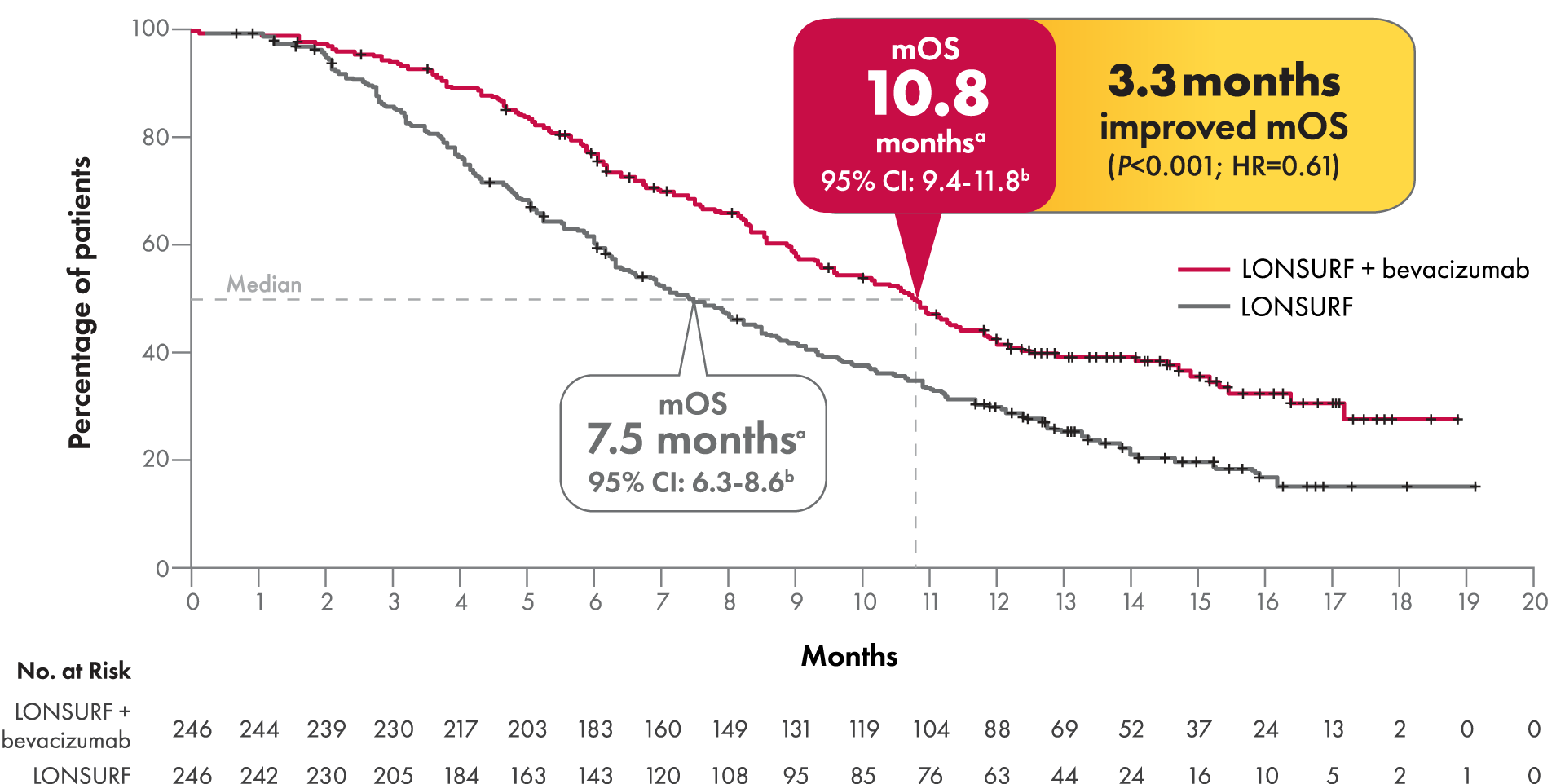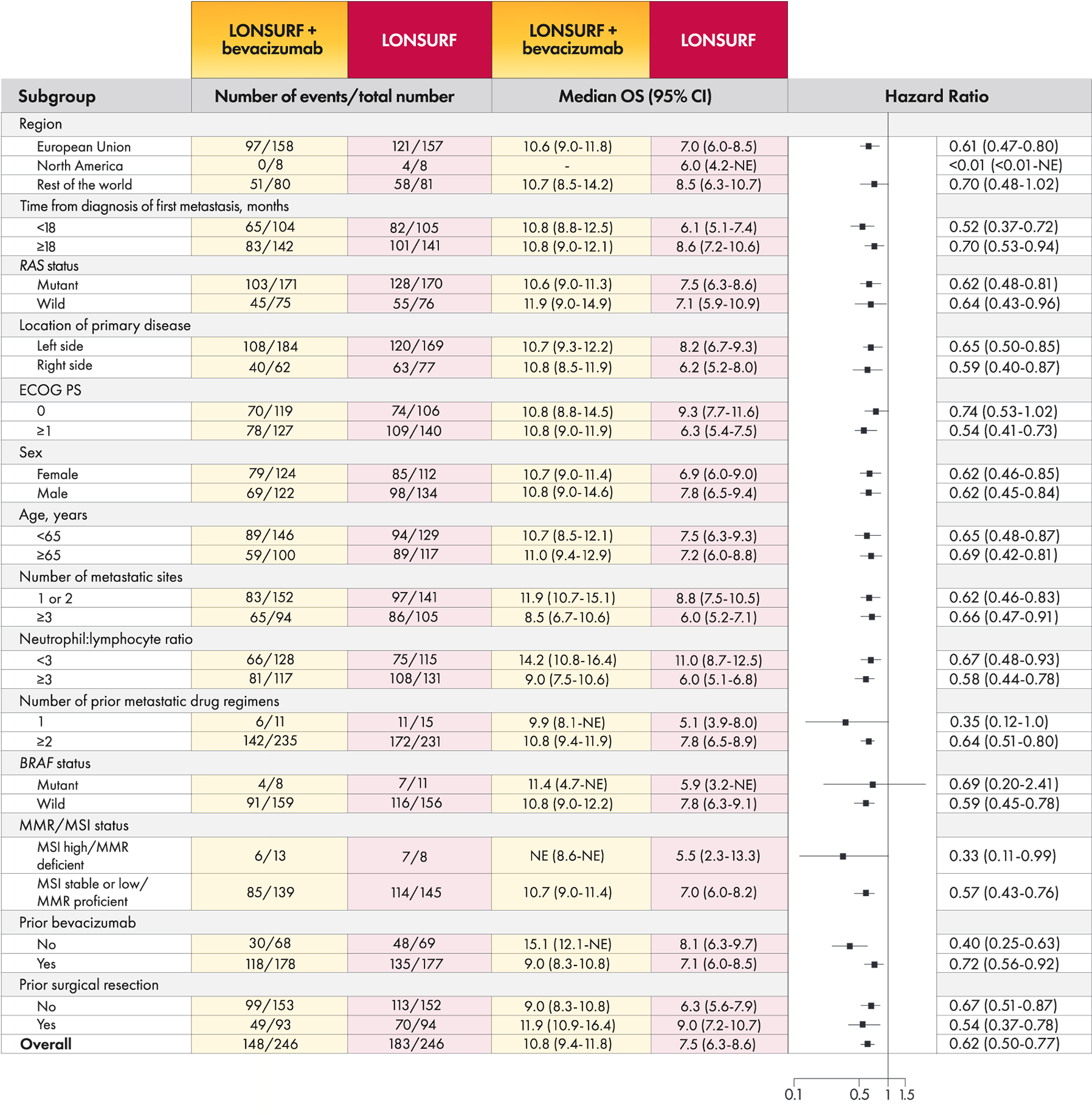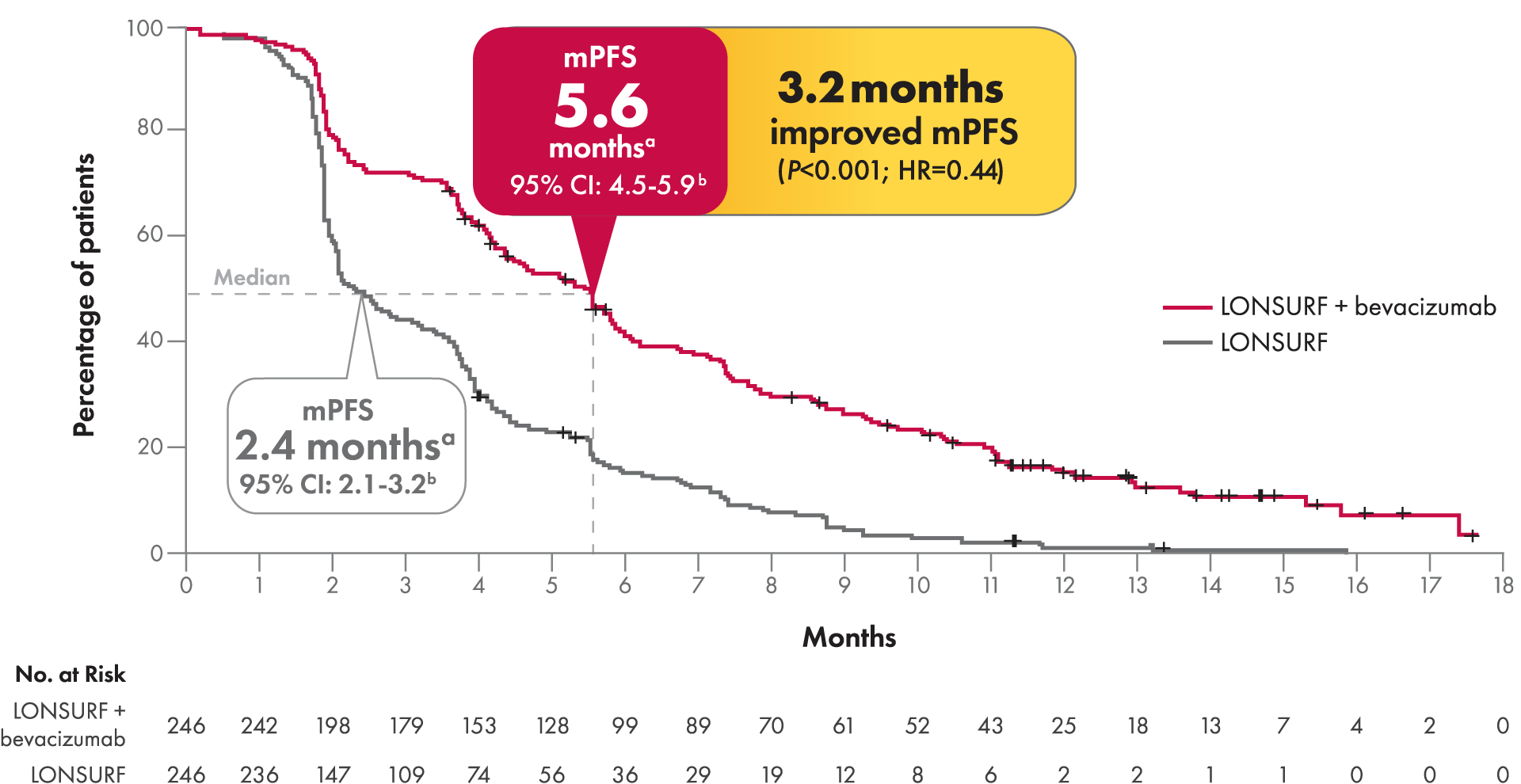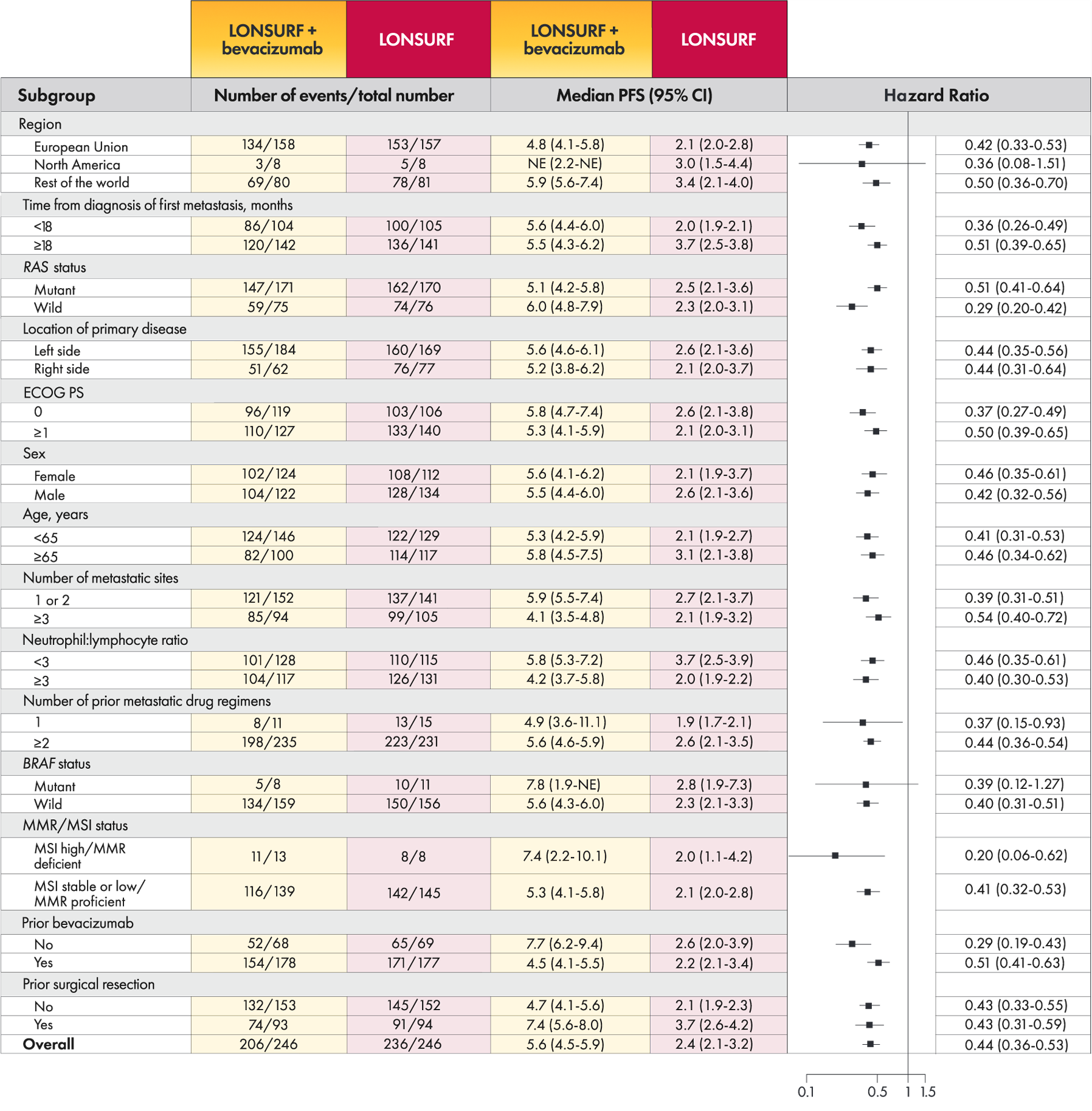Redefine Expectations in 3L mCRC
LONSURF + bevacizumab was studied in the SUNLIGHT trial
SUNLIGHT is the first and only phase 3 study with an active control that demonstrated statistically significant efficacy and proven safety in 3L mCRC1-8
3L=3rd-line.
On this page
SUNLIGHT was an open-label, randomized, phase 3 study that investigated the efficacy and safety of LONSURF in combination with bevacizumab compared with single-agent LONSURF in patients with refractory metastatic colorectal cancer (mCRC).1,2
Key inclusion criteria1
- Histologically confirmed unresectable adenocarcinoma of the colon or rectum
- Disease progression or intolerance
- No more than 2 previous chemotherapy regimens*
- Previous treatment must have included a fluoropyrimidine, irinotecan, oxaliplatin, an anti‑VEGF monoclonal antibody (not necessarily bevacizumab), or an anti‑EGFR monoclonal antibody (for patients with RAS wild-type disease)
- Known RAS status
- Eastern Cooperative Oncology Group Performance Status (ECOG PS) of 0-1
1:1 Randomization1,2
FTD-TPI + bevacizumab (n=246)
FTD-TPI administered orally, BID at a starting dose of 35 mg/m2 of BSA on days 1-5 and on days 8-12 every 28 days
Bevacizumab administered intravenously at a dose of 5 mg/kg of body weight on days 1 and 15
FTD-TPI (n=246)
FTD-TPI administered orally, BID at a starting dose of 35 mg/m2 of BSA on days 1-5 and on days 8-12 every 28 days
Primary endpoint: Overall survival (OS)
Key secondary endpoints: Progression-free survival (PFS), objective response rate (ORR), time to worsening of ECOG PS score from 0 or 1 to 2 or more, adverse reactions (ARs)
- The 28-day cycle continued until disease progression, unacceptable toxic effects, or consent was withdrawn
- Follow-up was every 8 weeks for radiologic progression and/or survival status
BID=twice daily; BSA=body surface area; EGFR=epidermal growth factor receptor.
*The treatment could have included neoadjuvant or adjuvant chemotherapy if disease had recurred during treatment or within 6 months after the last administration of neoadjuvant or adjuvant therapy.1
Key baseline characteristics1
| Characteristic | LONSURF + bevacizumab (n=246) | LONSURF (n=246) | |
|---|---|---|---|
| Age | Median, years (range) | 62 (20-84) | 64 (24-90) |
| <65 years, n (%) | 146 (59) | 129 (52) | |
| ≥65 years, n (%) | 100 (41) | 117 (48) | |
| Sex, n (%) | Male | 122 (50) | 134 (55) |
| Race or ethnic group, n (%) | White | 215 (87) | 220 (89) |
| Black | 4 (2) | 3 (1) | |
| Asian | 0 | 1 (<1) | |
| American Indian or Alaska Native | 1 (<1) | 0 | |
| Other | 8 (3) | 5 (2) | |
| Unknown | 18 (7) | 17 (7) | |
| Region, n (%) | European Union | 158 (64) | 157 (64) |
| North America | 8 (3) | 8 (3) | |
| Rest of the world | 80 (33) | 81 (33) | |
| Location of primary tumor, n (%) | Right side | 62 (25) | 77 (31) |
| Left side | 184 (75) | 169 (69) | |
| Time from diagnosis of first metastasis to randomization,a n (%) |
<18 months | 104 (42) | 105 (43) |
| ≥18 months | 142 (58) | 141 (57) | |
| RAS status,a n (%) | Mutant | 171 (70) | 170 (69) |
| Wild-type | 75 (31) | 76 (31) | |
| Prior treatment with anti‑VEGF monoclonal antibody (mainly bevacizumab), n (%) |
Yes | 178 (72) | 176 (72) |
| ECOG PS, n (%) | 0 | 119 (48) | 106 (43) |
| 1 | 127 (52) | 139 (57) | |
| 2 | 0 | 1 (<1)b | |
aData were determined from the interactive web-based response system used for randomization.
bThe patient had an ECOG PS of 1 at randomization, but was assessed as having a score of 2 on day 1 of the first cycle of treatment.
Redefine extended survival in 3L mCRC
Primary endpoint: Overall Survival (OS) (N=492)1,2

OS was defined as the time (in months) from randomization until death.1
HR and P values refer to the entire OS curve, and not any individual timepoint.
aKaplan-Meier estimates.
bThe widths of the confidence intervals have not been adjusted for multiplicity.1
- 39% reduction in risk of mortality with LONSURF + bevacizumab vs single-agent LONSURF2
- 6-month OS with LONSURF + bevacizumab was 77% vs 61% for single-agent LONSURF1
- 12-month OS with LONSURF + bevacizumab was 43% vs 30% for single-agent LONSURF1
- 18-month OS with LONSURF + bevacizumab was 28% vs 15% for single-agent LONSURF9
CI=confidence interval; HR=hazard ratio; mOS=median OS.

Within individual subgroups, it is difficult to apply statistical weight due to potential multiplicity issues, so these results should be interpreted with caution and no conclusions should be drawn.
MMR=mismatch repair; MSI=microsatellite instability; NE=not evaluable.
Results were consistent across all clinically relevant subgroups regardless of age, sex, location of primary disease, number of metastatic sites, RAS mutation status, and prior bevacizumab treatment1
Redefine prolonged PFS in 3L mCRC
Secondary endpoint: Progression-free Survival (PFS) (N=492)1,2

HR and P values refer to the entire PFS curve, and not any individual timepoint.
aKaplan-Meier estimates.
bThe widths of the confidence intervals have not been adjusted for multiplicity.1
- 56% reduction in risk of progression with LONSURF + bevacizumab vs single-agent LONSURF2
- 6-month PFS was 43% in LONSURF + bevacizumab vs 16% for single-agent LONSURF1
- 12-month PFS was 16% in LONSURF + bevacizumab vs 1% for single-agent LONSURF1
- Just before 18 months, the PFS for both treatment arms went to 01
mPFS=median PFS.

Within individual subgroups, it is difficult to apply statistical weight due to potential multiplicity issues, so these results should be interpreted with caution and no conclusions should be drawn.
MMR=mismatch repair; MSI=microsatellite instability; NE=not evaluable.
Results were consistent across all clinically relevant subgroups regardless of age, sex, location of primary disease, number of metastatic sites, RAS mutation status, and prior bevacizumab treatment1
Time to Worsening of ECOG PS
Secondary endpoint: Median time to worsening to an ECOG PS of ≥2, months1

aThe widths of the confidence intervals have not been adjusted for multiplicity.
- LONSURF + bevacizumab provided a 46% reduction in risk of worsening to an
ECOG PS ≥2 vs single-agent LONSURF1
- Since analysis not adjusted for multiplicity, results should be interpreted with caution and conclusions should be limited
ECOG PS=Eastern Cooperative Oncology Group performance status.
Additional results
Additional secondary endpoint: Objective Response Rate (ORR)1
- Objective response rate was 6.1% in LONSURF + bevacizumab and 1.2% in single-agent LONSURF
- ORR was a secondary endpoint that was studied in SUNLIGHT and is not reflected in the full Prescribing Information
Median duration of treatment (months)1
- Median duration of treatment was 5.0 months in LONSURF + bevacizumab and 2.1 months in single‑agent LONSURF
- At the time of the analysis, 13% of the patients in LONSURF + bevacizumab and 1.6% of the patients in single-agent LONSURF were still receiving treatment. The most common reason for treatment discontinuation was disease progression
NCCN Guidelines® in metastatic colorectal cancer
NCCN
Recommended
The National Comprehensive Cancer Network® (NCCN®) recommend trifluridine and tipiracil (LONSURF) +/- bevacizumab as NCCN Category 2A recommended options for a potential third-line or subsequent treatment in mCRC patients. The trifluridine and tipiracil (LONSURF) + bevacizumab combination is preferred.10,11
Category 2A=based upon lower-level evidence, there is uniform NCCN consensus that the intervention is appropriate.
Referenced with permission from the NCCN Clinical Practice Guidelines in Oncology (NCCN Guidelines®) for Rectal Cancer V.1.2024. © National Comprehensive Cancer Network, Inc. 2024. All rights reserved. Accessed February 5, 2024. To view the most recent and complete version of the guideline, go online to NCCN.org.
Referenced with permission from the NCCN Clinical Practice Guidelines in Oncology (NCCN Guidelines®) for Colon Cancer V.1.2024. © National Comprehensive Cancer Network, Inc. 2024. All rights reserved. Accessed February 5, 2024. To view the most recent and complete version of the guideline, go online to NCCN.org.
NCCN makes no warranties of any kind whatsoever regarding their content, use or application and disclaims any responsibility for their application or use in any way.
NCCN=National Comprehensive Cancer Network.
References: 1. Prager GW, Taieb J, Fakih M, et al. Trifluridine‑tipiracil and bevacizumab in refractory metastatic colorectal cancer. N Engl J Med. 2023;388(18):1657-1667. 2. LONSURF [package insert]. Princeton, NJ: Taiho Oncology, Inc.; 2023. 3. Dasari NA, Lonardi S, Garcia-Carbonero R, et al. FRESCO-2: a global phase III multiregional clinical trial (MRCT) evaluating the efficacy and safety of fruquintinib in patients with refractory metastatic colorectal cancer [abstract]. Ann Oncol. 2022;33(suppl 7):S1391-S1392. 4. Evrard C, Messina S, Sefrioui D, et al. Heterogeneity of mismatch repair status and microsatellite instability between primary tumour and metastasis and its implications for immunotherapy in colorectal cancers. Int J Mol Sci. 2022;23(8):4427. doi:10.3390/ijms23084427. 5. Li J, Qin S, Xu RH, et al. Effect of fruquintinib vs placebo on overall survival in patients with previously treated metastatic colorectal cancer: the FRESCO randomized clinical trial. JAMA. 2018;319(24):2486-2496. 6. Kim TW, Shen L, Xu JM, et al. TERRA: a randomized, double-blind, placebo-controlled phase 3 study of TAS-102 in Asian patients with metastatic colorectal cancer [abstract]. Ann Oncol. 2016;27(suppl 6):vi149-vi206. 7. Li J, Qin S, Yau T, et al. CONCUR: a randomized, double-blind, placebo-controlled phase 3 study of regorafenib monotherapy in Asian patients with previously treated metastatic colorectal cancer (mCRC) [abstract]. Ann Oncol. 2014;25(2):ii105-ii117. 8. Grothey A, Van Cutsem E, Sobrero A, et al; CORRECT Study Group. Regorafenib monotherapy for previously treated metastatic colorectal cancer (CORRECT): an international, multicentre, randomised, placebo-controlled, phase 3 trial. Lancet. 2013;381(9863):303-312. 9. Data on file. Taiho Oncology, Inc., Princeton, NJ. 10. Referenced with permission from the NCCN Clinical Practice Guidelines in Oncology (NCCN Guidelines®) for Colon Cancer V.1.2024. © National Comprehensive Cancer Network, Inc. 2024. All rights reserved. Accessed February 5, 2024. To view the most recent and complete version of the guideline, go online to NCCN.org. 11. Referenced with permission from the NCCN Clinical Practice Guidelines in Oncology (NCCN Guidelines®) for Rectal Cancer V.1.2024. © National Comprehensive Cancer Network, Inc. 2024. All rights reserved. Accessed February 5, 2024. To view the most recent and complete version of the guideline, go online to NCCN.org.
INDICATIONS
LONSURF is indicated as a single agent or in combination with bevacizumab for the treatment of adult patients with metastatic colorectal cancer previously treated with fluoropyrimidine‑, oxaliplatin‑ and irinotecan‑based chemotherapy, an anti‑VEGF biological therapy, and if RAS wild‑type, an anti‑EGFR therapy.
LONSURF is indicated for the treatment of adult patients with metastatic gastric or gastroesophageal junction adenocarcinoma previously treated with at least two prior lines of chemotherapy that included a fluoropyrimidine, a platinum, either a taxane or irinotecan, and if appropriate,


INDICATIONS
LONSURF is indicated as a single agent or in combination with bevacizumab for the treatment of adult patients with metastatic colorectal cancer previously treated with fluoropyrimidine‑, oxaliplatin‑ and irinotecan‑based chemotherapy, an anti‑VEGF biological therapy, and if RAS wild‑type, an anti‑EGFR therapy.
LONSURF is indicated for the treatment of adult patients with metastatic gastric or gastroesophageal junction adenocarcinoma previously treated with at least two prior lines of chemotherapy that included a fluoropyrimidine, a platinum, either a taxane or irinotecan, and if appropriate,
IMPORTANT SAFETY INFORMATION
WARNINGS AND PRECAUTIONS
Severe Myelosuppression: In the 1114 patients who received LONSURF as a single agent, LONSURF caused severe or life‑threatening myelosuppression (Grade 3‑4) consisting of neutropenia (38%), anemia (17%), thrombocytopenia (4%) and febrile neutropenia (3%). Three patients (0.3%) died due to neutropenic infection/sepsis; four other patients (0.5%) died due to septic shock. A total of 14% of patients received granulocyte‑colony stimulating factors. In the 246 patients who received LONSURF in combination with bevacizumab, LONSURF caused severe or life-threatening myelosuppression (Grade 3‑4) consisting of neutropenia (52%), anemia (5%), thrombocytopenia (4%) and febrile neutropenia (0.4%). One patient (0.4%) died due to abdominal sepsis and two other patients (0.8%) died due to septic shock. A total of 29% of patients received granulocyte-colony stimulating factors. Obtain complete blood counts prior to and on Day 15 of each cycle of LONSURF and more frequently as clinically indicated. Withhold LONSURF for severe myelosuppression and resume at the next lower dosage.
Embryo‑Fetal Toxicity: LONSURF can cause fetal harm when administered to a pregnant woman. Advise pregnant women of the potential risk to the fetus. Advise females of reproductive potential to use effective contraception during treatment and for at least 6 months after the final dose.
USE IN SPECIFIC POPULATIONS
Lactation: It is not known whether LONSURF or its metabolites are present in human milk. There are no data to assess the effects of LONSURF or its metabolites on the breastfed child or the effects on milk production. Because of the potential for serious adverse reactions in breastfed children, advise women not to breastfeed during treatment with LONSURF and for 1 day following the final dose.
Male Contraception: Because of the potential for genotoxicity, advise males with female partners of reproductive potential to use condoms during treatment with LONSURF and for at least 3 months after the final dose.
Geriatric Use: Patients 65 years of age or older who received LONSURF as a single agent had a higher incidence of the following hematologic laboratory abnormalities compared to patients younger than 65 years: Grade 3 or 4 neutropenia (46% vs 32%), Grade 3 anemia (20% vs 14%), and Grade 3 or 4 thrombocytopenia (6% vs 3%). Patients 65 years of age or older who received LONSURF in combination with bevacizumab had a higher incidence of the following hematologic laboratory abnormalities compared to patients younger than 65 years: Grade 3 or 4 neutropenia (60% vs 46%) and Grade 3 or 4 thrombocytopenia (5% vs 4%).
Renal Impairment: No adjustment to the starting dosage of LONSURF is recommended in patients with mild or moderate renal impairment (CLcr of 30 to 89 mL/min). Reduce the starting dose of LONSURF for patients with severe renal impairment (CLcr of 15 to 29 mL/min) to a recommended dosage of 20 mg/m2.
Hepatic Impairment: Do not initiate LONSURF in patients with baseline moderate or severe (total bilirubin > 1.5 times ULN and any AST) hepatic impairment. Patients with severe hepatic impairment (total bilirubin > 3 times ULN and any AST) were not studied. No adjustment to the starting dosage of LONSURF is recommended for patients with mild hepatic impairment.
ADVERSE REACTIONS
Serious adverse reactions occurred in 25% of patients. The most frequent serious adverse reactions (≥2%) were intestinal obstruction (2.8%), and COVID-19 (2%). Fatal adverse reactions occurred in 1.2% of patients who received LONSURF in combination with bevacizumab, including rectal fistula (0.4%), bowel perforation (0.4%) and atrial fibrillation (0.4%).
The most common adverse reactions or laboratory abnormalities (≥10% in incidence) in patients treated with single‑agent LONSURF at a rate that exceeds the rate in patients receiving placebo in mCRC: anemia (77% vs 33%), neutropenia (67% vs 0.8%), asthenia/fatigue (52% vs 35%), nausea (48% vs 24%), thrombocytopenia (42% vs 8%), decreased appetite (39% vs 29%), diarrhea (32% vs 12%), vomiting (28% vs 14%), abdominal pain (21% vs 19%), and pyrexia (19% vs 14%). In metastatic gastric cancer or gastroesophageal junction (GEJ): neutropenia (66% vs 4%), anemia (63% vs 38%), nausea (37% vs 32%), thrombocytopenia (34% vs 9%), decreased appetite (34% vs 31%), vomiting (25% vs 20%), infections (23% vs 16%) and diarrhea (23% vs 14%).
Pulmonary emboli occurred more frequently in LONSURF‑treated patients compared to placebo: in mCRC (2% vs 0%) and in metastatic gastric cancer and GEJ (3% vs 2%).
Interstitial lung disease (0.2%), including fatalities, has been reported in clinical studies and clinical practice settings in Asia.
The most common adverse reactions or laboratory abnormalities (≥20% in incidence) in patients treated with LONSURF in combination with bevacizumab vs LONSURF alone were neutropenia (80% vs 68%), anemia (68% vs 73%), thrombocytopenia (54% vs 29%), fatigue (45% vs 37%), nausea (37% vs 27%), increased aspartate aminotransferase (34% vs 28%), increased alanine aminotransferase (33% vs 23%), increased alkaline phosphate (31% vs 36%), decreased sodium (25% vs 20%), diarrhea (21% vs 19%), abdominal pain (20% vs 18%), and decreased appetite (20% vs 15%).

